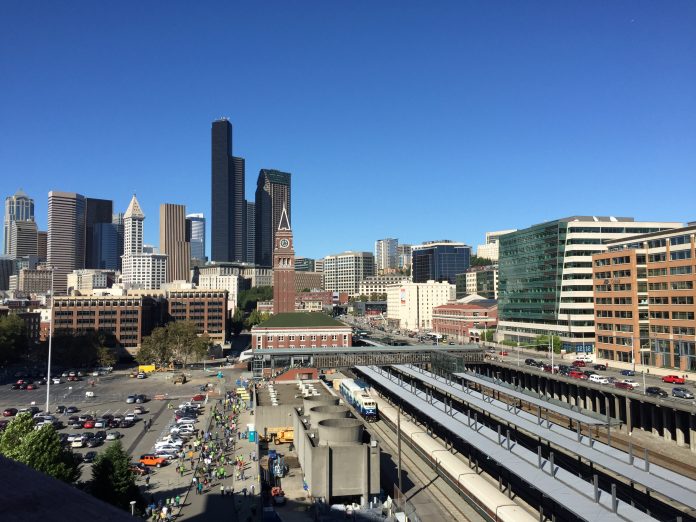Soon Seattle will find out what alternatives for the West Seattle and Ballard light rail extensions in Chinatown-International District and SoDo survive the alternatives process. In mid-September, Sound Transit will provide an update on them at a neighborhood forum and open house at Union Station. Other corridor segments will also get their own forums around the same time.
In July, Sound Transit staff shared several new Level 1 alternatives (planning jargon for preliminary alignment concepts) for the light rail extensions in SoDo and Chinatown-International District to the Elected Leadership Group to consider. The new alternatives build upon public feedback received during the Level 1 alternatives process to evaluate options well outside of the narrow alternatives originally presented for those corridors. Other segments such as Interbay, Downtown Seattle and South Lake Union, and West Seattle had a much wider array of alternatives considered and taken into the Level 2 evaluation phase earlier in the process.
Based upon the alternatives presented by Sound Transit staff, the Elected Leadership Group decided to carry forward four SoDo alternatives and five Chinatown-International District alternatives. Only three key alternatives were originally considered after proceeding through the initial Level 1 alternatives phase for the two segments in addition a small variation on station location in Chinatown-International District.
SoDo Level 1 Alternatives Under Consideration
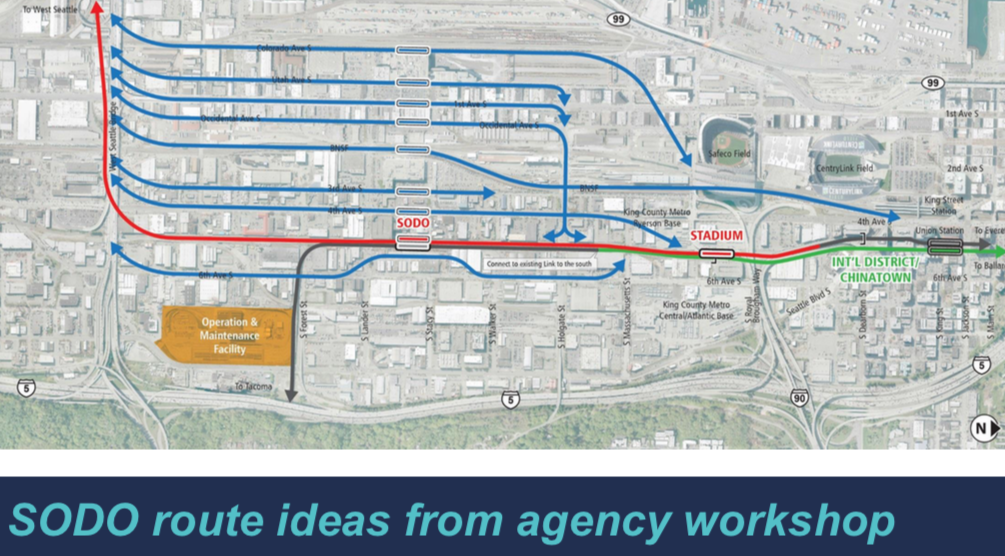
In developing new alternatives to the representative alignment on the E-3 busway in SoDo, Sound Transit considered a variety of different options to route trains down north-south streets from S Colorado Ave to 6th Ave S, just east of the busway. Many of them present serious challenges, such as sharp turns, private land acquisition, and crossing the major railway corridor splitting SoDo and the Duwamish Industrial District. A factor in brainstorming alternatives was a strong desire to bring the West Seattle extension to Chinatown-International District sooner in the buildout process instead forcing five years of transfers at SoDo Station until an extension further northward is completed as part of the Ballard extension.
There is promise and validity to some of the options, particularly near 1st Ave S which is a burgeoning commercial corridor flanked by warehouses and industry. Bringing direct light rail service could supplement local bus service on and near the corridor and provide better access to jobs. The main tradeoff for transit riders of the west-of-the-E-3-busway options is the backtracking from Stadium Station or International District/Chinatown Station that would be required to head toward the airport and Rainier Valley. Under any scenario, backtracking to International District/Chinatown Station would be necessary to reach the Eastside on Link.
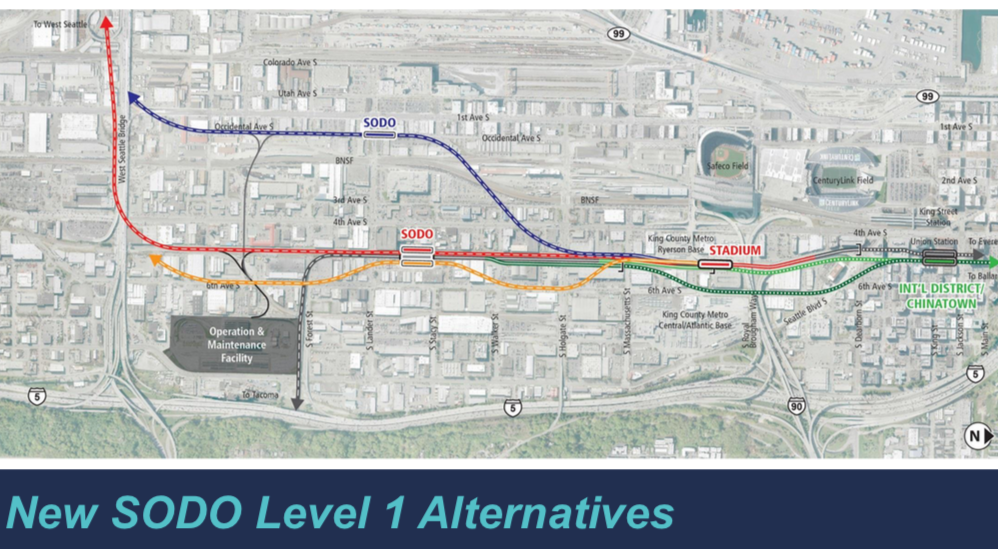
Instead of directly serving 1st Ave S, Sound Transit staff considered an alignment along Occidental Ave S, a half-block to the east. A stop in SoDo under that alternative would loosely be at S Lander St, possibly straddling it. The alignment would primarily be elevated and dive across the main railway corridor between S Lander St and S Holgate St before joining up with the existing light rail corridor. The concept, however, presents some issues that Sound Transit rather not deal with, such as a need to buy up property and demolish structures as well as a special spur to the operations and maintenance facility to the east.
Separately, Sound Transit evaluated a 6th Ave S alignment, which would jog back and forth just east of the existing light rail line in SoDo. While the alignment would still serve the same SoDo stop as the existing line today, the alternative is plagued by some of the same technical challenges as the Occidental Ave S alternative, rendering it an unlikely choice. Ultimately, it was removed from further consideration.
One question that Sound Transit is grappling with is what to do with the E-3 busway in SoDo, which is evidently the transit agency’s preferred corridor, other options aside. King County Metro Transit and Sound Transit rely heavily on the corridor today to move buses, particularly at peak hours with some 60 trips per hour in a single direction. Any alternative that involves double duty for trains down the busway could affect performance if the busway is still needed once the West Seattle light rail extension is completed. In fact, construction of new light rail facilities could still affect ongoing operations during buildout.
Staff at Sound Transit did recommend moving forward an earlier concept known as the “Massachusetts Tunnel Portal.” That alternative would help split trains traveling on the E-3 busway into two separate alignments to support the tunnel weave for the West Seattle-Everett and Ballard-Tacoma corridor pairs.
Chinatown-International District Level 1 Alternatives Under Consideration
In May, Sound Transit met with community members in Chinatown-International District to get a sense of priorities and reactions to the Level 1 alternatives. There were several key issues that arose from that process: activating Union Station, improving intermodal connections in the area, and minimizing construction impacts to Chinatown.
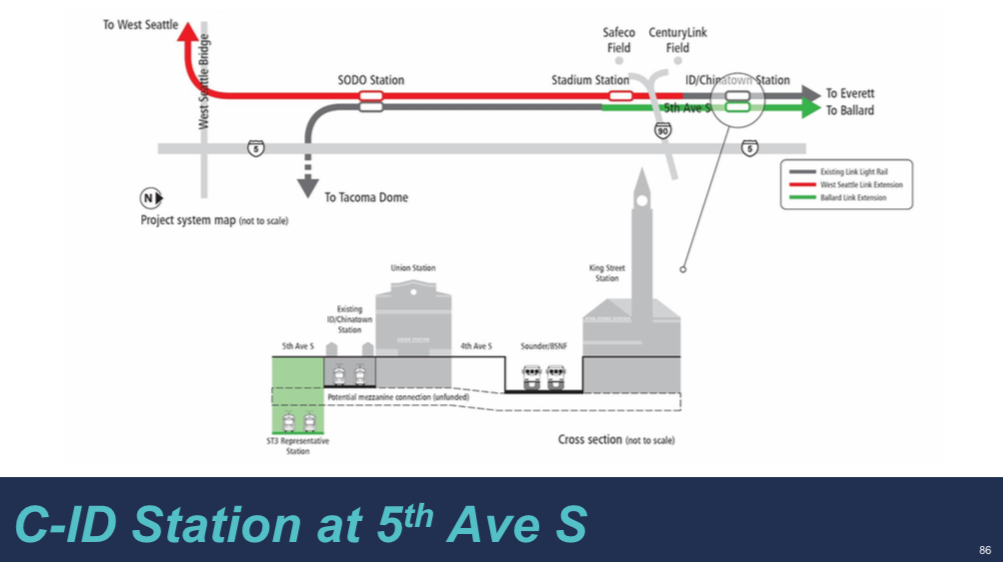
Earlier on in the Level 1 alternatives process, Sound Transit primarily considered construction of a new tunnel just east of the existing one, whether bored or cut-and-cover, on 5th Ave S. That street happens to be an incredibly busy artery for existing bus service and local traffic (about 8,500 daily vehicle trips) and gateway to Chinatown. Community members and business owners felt that disruptions to the street to expand the station and lay down a new tunnel shell could be devastating to local businesses. Sound Transit has considered several options to mitigate this, such as moving the station expansion slightly north, possibly north of S Jackson St and boring a tunnel instead of using the cheaper but more disruptive cut-and-cover method.
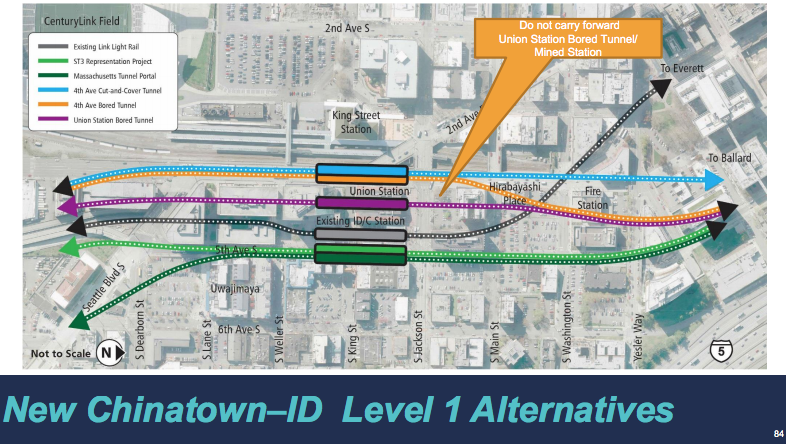
Responding to these concerns and to public support for reuse of Union Station and service west of 5th Ave S apparently pushed Sound Transit staff to develop a menu of additional alternatives. These include a cut-and-cover tunnel on 4th Ave S, a bored tunnel on 4th Ave S, and bored tunnel under Union Station–the latter which the agency has already been dismissed due to significant technical challenges.
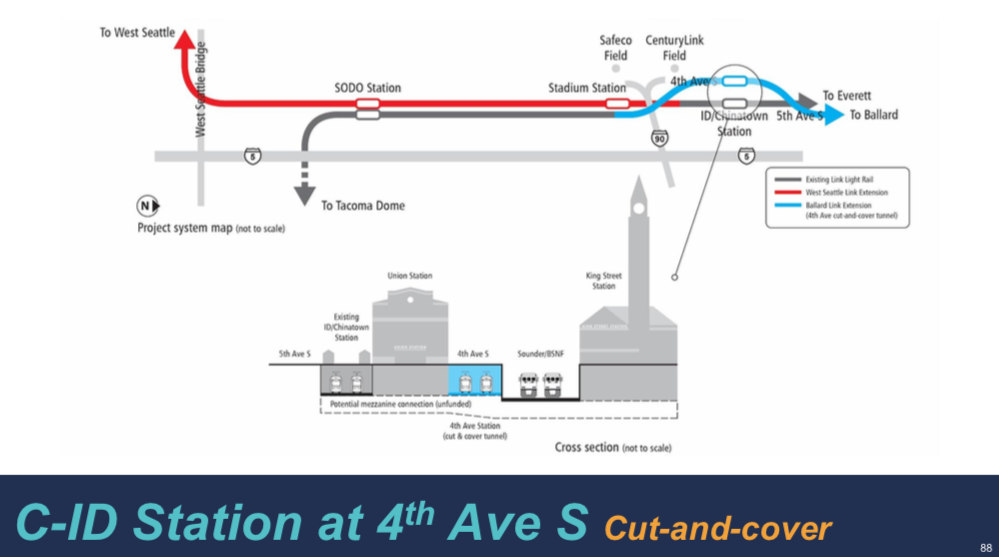
If a cut-and-cover option on 4th Ave S is sought, Sound Transit estimates that construction time would range from 4.5 to 5.5 years and require four key stages of work from Seattle Blvd S to Jefferson Street. Construction of the station and cut-and-cover tunnel would be disruptive in its own right. Buses and general traffic (about 33,000 daily vehicle trips) that use the street as primary arterial to the city center would be heavily affected by the street closure, which presumably would entail full closure given that the street is built on a viaduct.
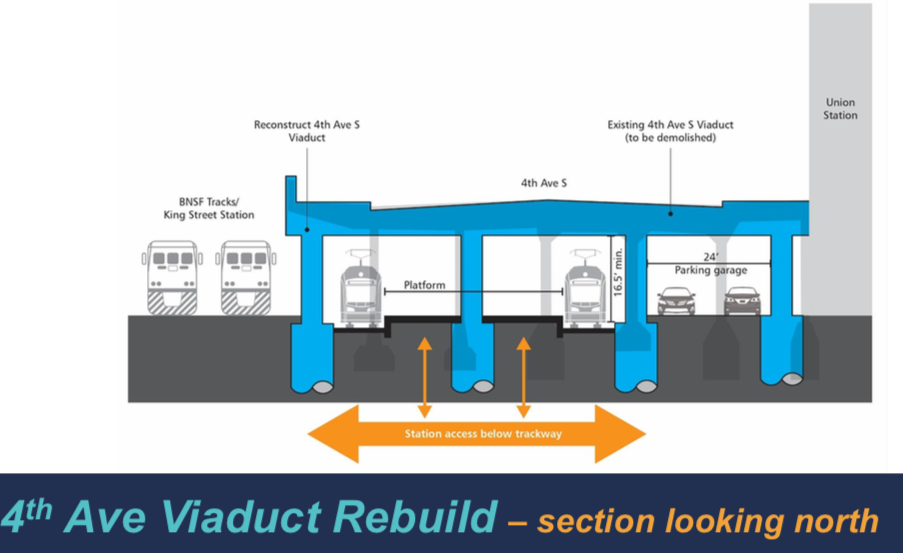
The city for its part, however, has an interest in its reconstruction since the viaduct is reaching its design life. Additionally, the cut-and-cover option presents a very straightforward way to construct a mezzanine below ground that links together the existing platforms at International District/Chinatown Station and King Street Station to the new 4th Ave S station and its platforms. Presumably, new entrances to the surface from the station would be constructed, such as through Union Station or on 4th Ave S itself.
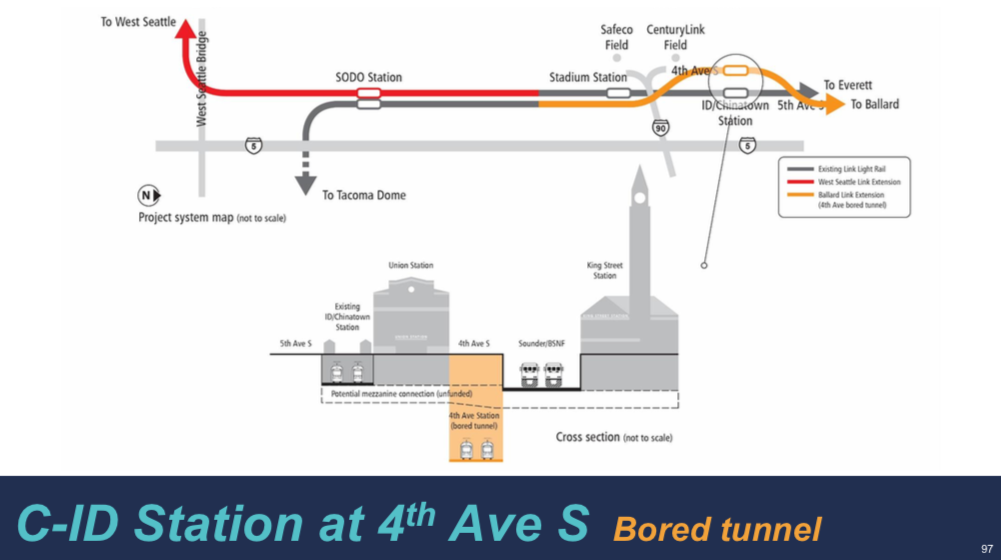
A bored tunnel under 4th Ave S could take even longer than cut-and-cover at five to six years. This is because it would be a two-stage process: replace the existing viaduct and then bore deep below. The soils in the area primarily from fill with the viaduct and existing buildings built atop pilings. A deep bored station simply wouldn’t be feasible without dealing with the existing structures above since there would be high risk of destabilization. That means the station would have to be bored very deep. The I-90 ramps may also need to be altered to accommodate the alignment.
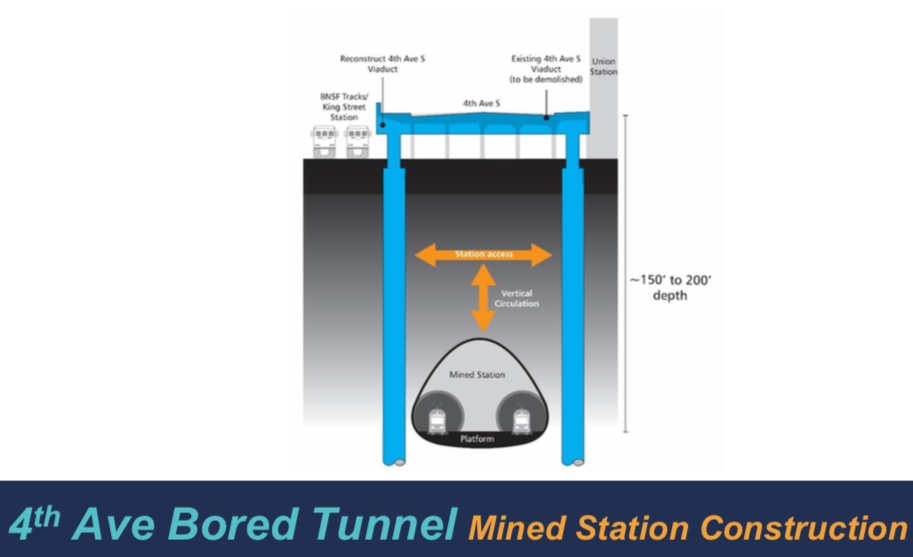
The distance from surface to the bottom of the bored tunnel would be somewhere between 150 feet and 200 feet. Digging that deep would be no small undertaking and require substantial vertical circulation to get passengers from the surface and adjoining stations to and from the platform. For comparison, platforms at University of Washington Station and Capitol Hill Station are 90 feet and 65 feet from the surface, respectively.
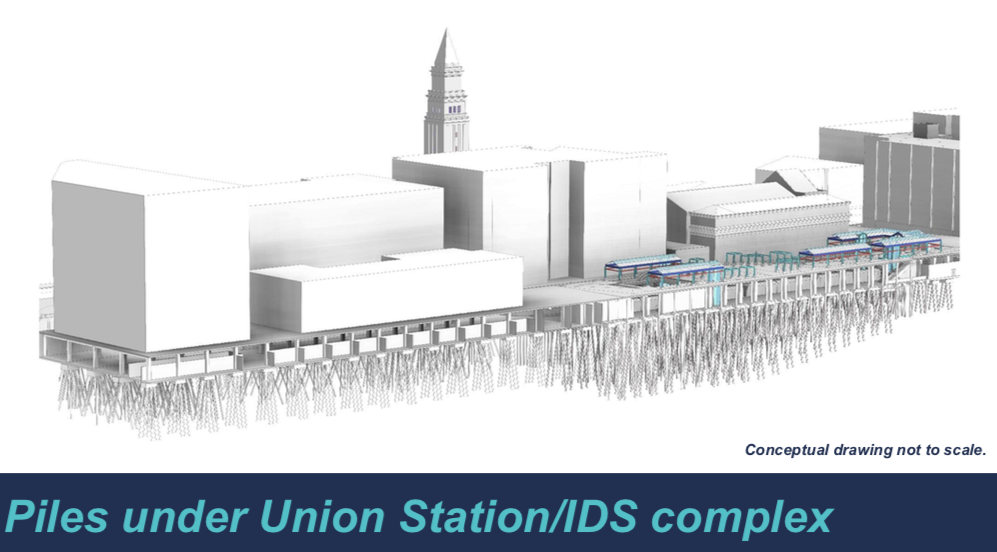
However, the bored tunnel option would provide some of the same benefits for mezzanine connections to other stations in area like the 4th Ave S cut-and-cover option, but at a much higher cost and longer disruptions.
Under either 4th Ave S scenario, the City of Seattle has been put on notice that they would need to be a funding partner since the 4th Ave S viaduct would need to be replaced to accommodate light rail below. Sound Transit is not willing to bear the full cost of replacement to make the alternatives happen. Interestingly, a portion of the space below the viaducts are dedicated to underground parking for Sound Transit personnel and vehicles.
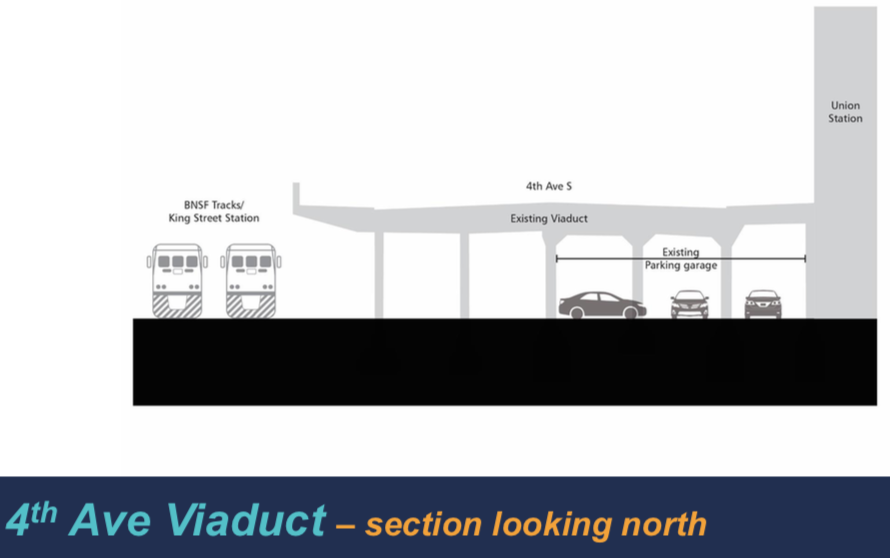
Another common challenge for both options is how to direct the alignments of the new Ballard extension to connect up with the South Link line to Tacoma. The alignment would have to dance around the new West Seattle extension that will connect into the North Link line to Everett. That means going under that tunnel twice instead of just once with the proposed concepts, which adds obvious risk and requires delicate engineering to pull off. By extension, that translates to more money and presumably longer timelines for construction.
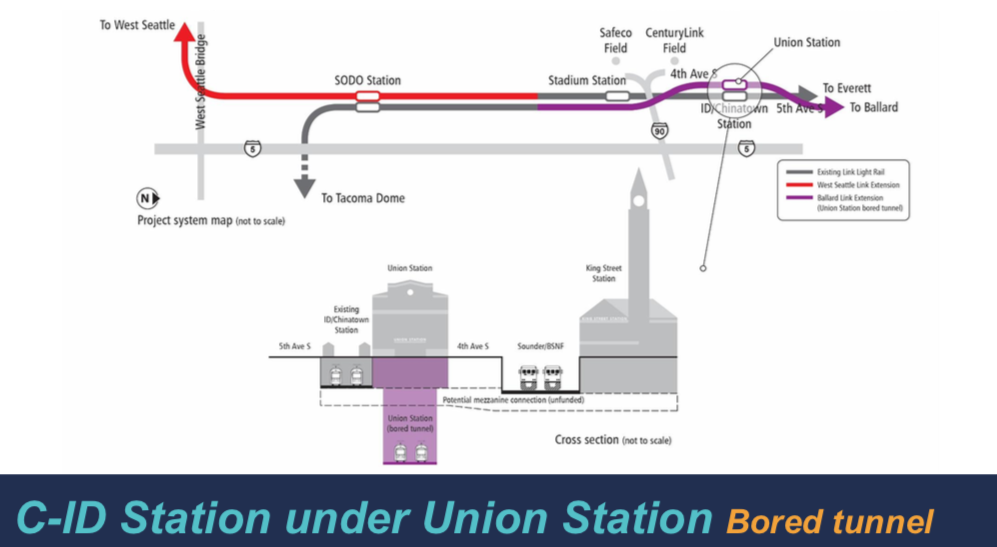
As noted before, Sound Transit staff recommended against further consideration of a bored tunnel beneath Union Station, which is the headquarters of Sound Transit and a former passenger railway station. This advice was based on a myriad of technical constructibility challenges and the fact that a tunnel could not directly go into the station–at best the station could be used as a mezzanine.
Instead, Sound Transit staff are following upon how Union Station might fit into the equation of the multimodal area: the existing light rail tunnel immediately to the east, King Street Station just west of 4th Ave S where Sounder and Amtrak services are located, the Seattle Streetcar on S Jackson St, and nearby streets for local and regional bus service.
In April, The Urbanist shared a vision to reactive Union Station as a centerpiece to the multimodal hub at S Jackson St. From the Elected Leadership Group presentation, it appears that the sentiment was widely shared by many people leading to it getting special attention by staff in how to address it. At the May community meeting, Sound Transit designers were all too eager to come up with options of how Union Station could be reused and incorporated into the overall station area as part of the Ballard and West Seattle extensions.
Several ideas were discussed for giving the grand hall at Union Station a makeover as a place for local retail, restaurants, and waiting space. New access directly to International/Chinatown Station to the platforms might be possible, which evidently could be achieved by removing a metal lattice screen next to the west platform. This would allow access to the hidden garden-level terrace of Union Station. Other possible changes include fully rethinking the existing above-ground plaza at International District/Chinatown Station and the station’s vertical access, and punching through a new public access through the rear corridor of Union Station at its surface-level southend. Whether or not this will be further fleshed out next month is not yet clear given its fined-grained detail, but it obviously could play a direct role in station locations and design at Chinatown-International District and Pioneer Square.
If you have an interest in these alternatives, it may be worth your time to attend the neighborhood forum and open house on Tuesday, September 11th at Union Station (RSVPs are recommended). The meeting will run from 5.30pm to 8.00pm with interpreters available for people who speak Cantonese or Vietnamese.
Disclosure: The author attended one of the Chinatown-International District community meetings with Sound Transit and provided feedback on concepts and priorities.
Sound Transit Releases Ballard and West Seattle Level 1 Results
Stephen is a professional urban planner in Puget Sound with a passion for sustainable, livable, and diverse cities. He is especially interested in how policies, regulations, and programs can promote positive outcomes for communities. With stints in great cities like Bellingham and Cork, Stephen currently lives in Seattle. He primarily covers land use and transportation issues and has been with The Urbanist since 2014.

